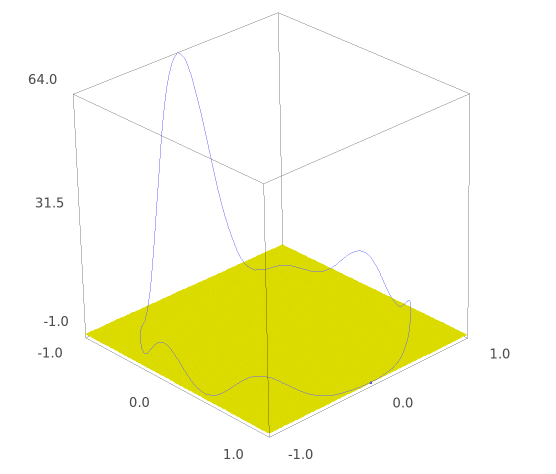This equation $e=0$ is polynomial in $c_1=\cos(t_1), s_1=\sin(t_1), c_2=\cos(t_2), s_2=\sin(t_2)$. Explicitly:
sage: var('t1,t2')
sage: eqn = (cos(t1)*cos(t2) - sin(t1)*sin(t2) - cos(t1))*(cos(t2)*sin(t1) + (cos(t1) + 1)*sin(t2)) - ((cos(t1) - 1)*cos(t2) - sin(t1)*sin(t2))*(cos(t2)*sin(t1) + cos(t1)*sin(t2) + sin(t1)) ==0
sage: R.<c1,s1,c2,s2> = PolynomialRing(QQ, order='lex')
sage: trig_to_poly = lambda expr: R(str(expr).replace('cos(t1)','c1').replace('sin(t1)','s1').replace('cos(t2)','c2').replace('sin(t2)','s2'))
sage: e = trig_to_poly(eqn.lhs()); e
-c1^2*s2 - 2*c1*s1*c2 + 2*c1*c2*s2 - c1*s2 + s1^2*s2 + s1*c2^2 + s1*c2 - s1*s2^2
Calculate a Groebner basis of the ideal $\langle e, c_1^2+s_1^2-1, c_2^2+s_2^2-1 \rangle$ in $\mathbb{Q}[c_1,s_1,c_2,s_2]$ with respect to the lexicographic monomial ordering $c_1 > s_1 > c_2 > s_2$:
sage: GB = R.ideal(e,c1^2+s1^2-1,c2^2+s2^2-1).groebner_basis(); GB
[c1^2 + s1^2 - 1, c1*s1 + 8*c1*s2^5 - 6*c1*s2^3 - 1/2*c1*s2 + 4*s1^3*c2 - 8*s1^3*s2^2 + 6*s1^3 - 16*s1^2*c2*s2^3 + 8*s1^2*c2*s2 - 8*s1^2*s2^3 + 6*s1^2*s2 + 8*s1*c2*s2^4 - 10*s1*c2*s2^2 + 1/2*s1*c2 + 8*s1*s2^4 - 4*s1*s2^2 - 3/2*s1 + 4*c2*s2^3 - c2*s2 + 8*s2^5 - 8*s2^3 + 3/2*s2, c1*c2*s2 - 8*c1*s2^5 + 8*c1*s2^3 - c1*s2 - 4*s1^3*c2 + 8*s1^3*s2^2 - 8*s1^3 + 16*s1^2*c2*s2^3 - 12*s1^2*c2*s2 + 8*s1^2*s2^3 - 6*s1^2*s2 - 8*s1*c2*s2^4 + 12*s1*c2*s2^2 - 2*s1*c2 - 8*s1*s2^4 + 5*s1*s2^2 + 2*s1 - 4*c2*s2^3 + 3*c2*s2 - 8*s2^5 + 10*s2^3 - 3*s2, c1*s2^7 - 5/4*c1*s2^5 + 5/16*c1*s2^3 + 1/2*s1^3*c2*s2^2 - 1/4*s1^3*c2 - s1^3*s2^4 + 5/4*s1^3*s2^2 - 1/4*s1^3 - 2*s1^2*c2*s2^5 + 2*s1^2*c2*s2^3 - 3/8*s1^2*c2*s2 - s1^2*s2^5 + 5/4*s1^2*s2^3 - 3/8*s1^2*s2 + s1*c2*s2^6 - 7/4*s1*c2*s2^4 + 11/16*s1*c2*s2^2 + s1*s2^6 - s1*s2^4 + 1/16*s1*s2^2 + 1/2*c2*s2^5 - 3/8*c2*s2^3 + s2^7 - 3/2*s2^5 + 9/16*s2^3, s1^4 + 2*s1^3*c2*s2 - s1^3*s2 - 2*s1^2*c2*s2^2 + 1/2*s1^2*c2 - 1/2*s1^2 - 3/2*s1*c2*s2 - s1*s2^3 + 3/2*s1*s2 + c2*s2^2 + s2^4 - s2^2, c2^2 + s2^2 - 1]
This system of equations is equivalent to the original one, but it is "more triangular". The (familiar) last equation GB[-1] depends only on $c_2, s_2$ (hence $t_2$). The second-to-last equation GB[-2] depends only on $s_1,c_2,s_2$; it is quartic in $s_1$ with leading coefficient $1$, so we can solve for $s_1$ in terms of $c_2,s_2$ (hence $t_2$). In fact:
sage: GB[-2].factor()
(1/2) * (-s1 + s2) * (-2*s1^3 - 4*s1^2*c2*s2 - s1*c2 + s1 + 2*c2*s2 + 2*s2^3 - 2*s2)
So either $s_1=s_2$ or $s_1$ is a (real) root of that cubic. The discriminant of the cubic is:
sage: D = GB[-2].factor()[1][0].discriminant(s1); D
512*c2^4*s2^4 + 16*c2^4*s2^2 + 512*c2^3*s2^6 - 512*c2^3*s2^4 - 320*c2^3*s2^2 - 8*c2^3 - 288*c2^2*s2^4 + 160*c2^2*s2^2 + 24*c2^2 - 576*c2*s2^4 + 576*c2*s2^2 - 24*c2 - 432*s2^6 + 864*s2^4 - 432*s2^2 + 8
On the circle $c_2^2+s_2^2=1$ it has only one zero, at $(1,0)$:
sage: S = PolynomialRing(QQ,names='c2,s2')
sage: S.ideal([c2^2+s2^2-1,D]).variety()
[{s2: 0, c2: 1}]
Even though it looks a bit like it has more:
sage: var('x,y,z,t')
sage: implicit_plot3d(z==0,(x,-1,1),(y,-1,1),(z,-1,1),color='yellow') + parametric_plot3d([cos(t),sin(t),D.subs({c2:cos(t),s2:sin(t)})], (t,0,2*pi)) + point3d((1,0,0))

In any case, the discriminant of the cubic is $\geqslant 0$ on the circle $c_2^2+s_2^2=1$, so all roots of the cubic are real, and they are distinct when the discriminant is $\neq 0$; that is, away from $(1,0)$.
In conclusion: either $s_1 = s_2$ or $s_1$ is a real root of a cubic, which can be given by the cubic formula:
sage: SR(GB[-2]).solve(SR(s1))
[s1 == -2/3*c2*s2 - 1/36*(8*c2^2*s2^2 - 3*c2 + 3)*(-I*sqrt(3) + 1)/(-8/27*c2^3*s2^3 + 1/6*(c2 - 1)*c2*s2 + 1/2*s2^3 + 1/2*c2*s2 - 1/2*s2 + 1/6*sqrt(-1/3*(32*c2^3 - 27)*s2^6 - 2/3*(16*c2^4 - 16*c2^3 - 9*c2^2 - 18*c2 + 27)*s2^4 + 1/6*c2^3 - 1/3*(c2^4 - 20*c2^3 + 10*c2^2 + 36*c2 - 27)*s2^2 - 1/2*c2^2 + 1/2*c2 - 1/6))^(1/3) - 1/2*(-8/27*c2^3*s2^3 + 1/6*(c2 - 1)*c2*s2 + 1/2*s2^3 + 1/2*c2*s2 - 1/2*s2 + 1/6*sqrt(-1/3*(32*c2^3 - 27)*s2^6 - 2/3*(16*c2^4 - 16*c2^3 - 9*c2^2 - 18*c2 + 27)*s2^4 + 1/6*c2^3 - 1/3*(c2^4 - 20*c2^3 + 10*c2^2 + 36*c2 - 27)*s2^2 - 1/2*c2^2 + 1/2*c2 - 1/6))^(1/3)*(I*sqrt(3) + 1), s1 == -2/3*c2*s2 - 1/36*(8*c2^2*s2^2 - 3*c2 + 3)*(I*sqrt(3) + 1)/(-8/27*c2^3*s2^3 + 1/6*(c2 - 1)*c2*s2 + 1/2*s2^3 + 1/2*c2*s2 - 1/2*s2 + 1/6*sqrt(-1/3*(32*c2^3 - 27)*s2^6 - 2/3*(16*c2^4 - 16*c2^3 - 9*c2^2 - 18*c2 + 27)*s2^4 + 1/6*c2^3 - 1/3*(c2^4 - 20*c2^3 + 10*c2^2 + 36*c2 - 27)*s2^2 - 1/2*c2^2 + 1/2*c2 - 1/6))^(1/3) - 1/2*(-8/27*c2^3*s2^3 + 1/6*(c2 - 1)*c2*s2 + 1/2*s2^3 + 1/2*c2*s2 - 1/2*s2 + 1/6*sqrt(-1/3*(32*c2^3 - 27)*s2^6 - 2/3*(16*c2^4 - 16*c2^3 - 9*c2^2 - 18*c2 + 27)*s2^4 + 1/6*c2^3 - 1/3*(c2^4 - 20*c2^3 + 10*c2^2 + 36*c2 - 27)*s2^2 - 1/2*c2^2 + 1/2*c2 - 1/6))^(1/3)*(-I*sqrt(3) + 1), s1 == -2/3*c2*s2 + 1/18*(8*c2^2*s2^2 - 3*c2 + 3)/(-8/27*c2^3*s2^3 + 1/6*(c2 - 1)*c2*s2 + 1/2*s2^3 + 1/2*c2*s2 - 1/2*s2 + 1/6*sqrt(-1/3*(32*c2^3 - 27)*s2^6 - 2/3*(16*c2^4 - 16*c2^3 - 9*c2^2 - 18*c2 + 27)*s2^4 + 1/6*c2^3 - 1/3*(c2^4 - 20*c2^3 + 10*c2^2 + 36*c2 - 27)*s2^2 - 1/2*c2^2 + 1/2*c2 - 1/6))^(1/3) + (-8/27*c2^3*s2^3 + 1/6*(c2 - 1)*c2*s2 + 1/2*s2^3 + 1/2*c2*s2 - 1/2*s2 + 1/6*sqrt(-1/3*(32*c2^3 - 27)*s2^6 - 2/3*(16*c2^4 - 16*c2^3 - 9*c2^2 - 18*c2 + 27)*s2^4 + 1/6*c2^3 - 1/3*(c2^4 - 20*c2^3 + 10*c2^2 + 36*c2 - 27)*s2^2 - 1/2*c2^2 + 1/2*c2 - 1/6))^(1/3), s1 == s2]
Of course, $c_1 = \pm\sqrt{1-s_1}$.
To obtain $t_1$, restrict the range and apply $\arccos$ or $\arcsin$.
In case $(c_2,s_2) = (1,0)$ you get:
sage: GB[-2].subs({c2:1,s2:0})
s1^4
so $s_1 = 0$ and hence $c_1 = \pm 1$.
Edit: It still needs to be checked/proved that the roots of the cubic have magnitude $\leq 1$.
Edit 2: The numerical solution by @ortollj suggests that the solutions are in fact very simple expressions. One could try to improve the above approach by adding extra variables for the sine and cosine of double and half the angles, and trigonometric identities such as double-angle and half-angle formulae.




HI found 3 solutions graphically using SageMath, but I admit that I do not know the method to solve this kind of problem. if someone can explain to me the method to solve this kind of problem analytically, i am interested.I looked for the analytical solution all evening without success ;-(
solution on sagecell
@Ademorcerf: I suppose its an homework ? do you have the solution by hand ?